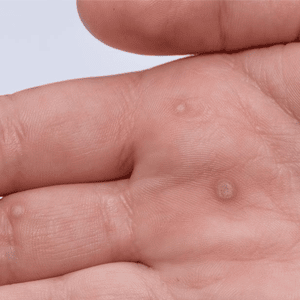
Warts are caused by certain types of human papillomavirus (HPV). Of the over 170 types of the HPV virus, only a small number cause common warts, plantar warts and flat warts. HPV, like other viruses, need to insert themselves into the DNA of cells in order to multiply and grow. What we observe as a wart on the skin is the end result of a process whereby an HPV virus enters into a skin cell causing the infected cell to multiply to eventually form a bump on the skin surface.
Given their viral nature, warts are contagious and can spread to the skin of others as well as oneself, especially if they are picked or scratched. The HPV virus only affects humans so contrary to popular belief, one cannot get warts by touching animals like frogs or toads. Warts can occasionally resolve on their own, but this may take years. Since they are contagious, it is recommended to treat them instead of waiting for them to resolve on their own.
So how are they treated?
Currently nearly all treatments involve different ways of physically destroying the cells that contain the virus rather than targeting the virus itself.
For small warts that are not located on face or lips, it is reasonable and safe to try treating at home. However, many home remedies, such as duct tape or apple cider vinegar application, are not supported by evidence and thus cannot be recommended. Certain over-the-counter products such as salicylic acid and freeze therapy, however, can be effective in clearing small warts. We recommend products with high concentration of salicylic acid, such as pads or plasters containing 40% salicylic acid. If the wart is not visibly smaller after 4 to 6 weeks of treatment we recommend seeking an in-office treatment by a board-certified dermatologist.
Dermatologists utilize several different modalities for treatment of warts in the office. The most commonly used treatment and likely most effective is liquid nitrogen (LN2). LN2 is liquefied nitrogen that has a temperature of -321 degrees Fahrenheit. Strategically applying it to the skin leads to a frostbite which destroys the skin cells that contain the virus. There is discomfort during the treatment since the LN2 is so cold, but usually this sensation disappears after 10 to 30 minutes. Depending on how aggressively the treatment is done and in what area of the body, a blister can form which can fill with water or blood. Other in-office treatment strategies include topical medications that induce a blistering reaction on the skin such as cantherone. Another in-office treatment for resistant warts is injection of candida antigen, a protein solution extracted from a common yeast called candida albicans, into the wart. This triggers the patient’s own immune system to fight off the foreign candida antigen and in the process the cells containing the virus are also targeted. There are several prescription creams that essentially work through a similar process for treatment of warts. Finally, very resistant warts can be treated with lasers and removal by minor surgery.
No matter the treatment modality you receive in the office, it’s important to note that warts can be quite resistant to treatment and may require multiple treatment sessions to resolve. These sessions are usually spaced out 3-4 weeks apart. It is important to be consistent with the treatment schedule your dermatologist recommends in order to prevent the warts from re-growing in between treatments.
While warts are relatively harmless, they can be a source of significant nuisance and may be contagious. If home remedies have been unsuccessful, we recommend scheduling an appointment with a board-certified dermatologist for an effective treatment strategy.
